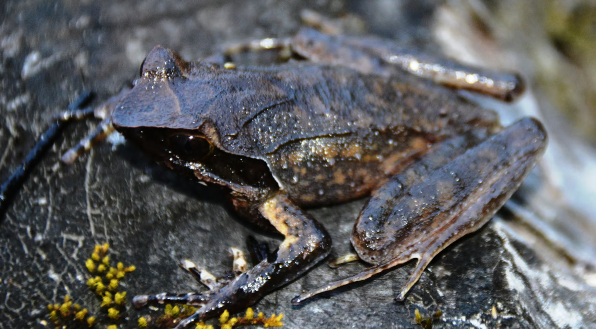New Horned Frog Species Discovered in Northeast India (GS Paper 3, Environment)

Introduction
- Scientists from the Zoological Survey of India (ZSI) have identified a new species of horned frog, Xenophrys apatani, in the Tale Wildlife Sanctuary of Arunachal Pradesh, a heavily forested region in northeastern India.
- Initially thought to be the Maoson horned frog (Xenophrys maosonensis) found in Vietnam and China, further research revealed distinct differences in morphology and genetics, establishing it as a separate species.
Identification and Research
- The discovery was made by a team from ZSI facilities in Shillong, Pune, and Itanagar.
- Through extensive morphological and genetic analyses, they identified clear distinctions between the Indian and Vietnamese frogs.
- Genetic testing revealed a 4.4% to 5.5% difference from the Maoson horned frog, confirming it as a new species.
Biogeographical Significance
- The discovery highlights the biogeographic separation between the regions inhabited by these genetically distinct species.
- The habitats in Northeast India and Vietnam are approximately 1,600 km apart, underscoring the influence of geographical boundaries on species evolution and diversity.
Integration with Local Culture
- The species is named after the Apatani tribe from the Lower Subansiri Valley, honoring their environmental conservation efforts in Arunachal Pradesh.
- This naming choice underscores the connection between indigenous communities and the region's biodiversity.
About Xenophrys apatani
- Discovery and Habitat: Found in the Talle Valley Wildlife Sanctuary in Arunachal Pradesh, Xenophrys apatani resides primarily under leaf litter in subtropical forests. The species, first discovered by Indian researchers in 2019, emphasizes the importance of preserving ecologically sensitive areas amid habitat loss.
- Distinctive Features: This megophryid frog is characterized by its unique brown coloration with dark spots, providing effective camouflage in its natural habitat. Its distinctive appearance contributes to the diverse fauna of the Eastern Himalayas.
- Conservation Significance: The discovery of Xenophrys apatani highlights the critical need for the conservation of these habitats to protect their unique biodiversity.
Conclusion
- The identification of Xenophrys apatani is a significant contribution to herpetology and underscores the importance of preserving the biodiversity of the Eastern Himalayas.
- It also reflects the vital role of indigenous communities in environmental conservation efforts.


